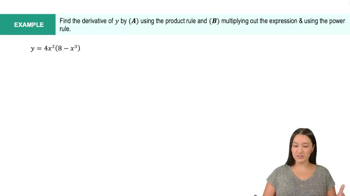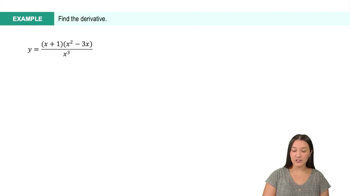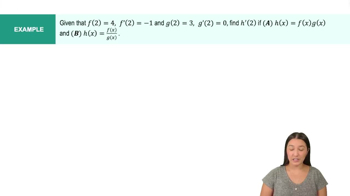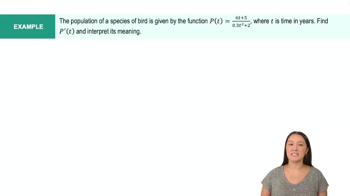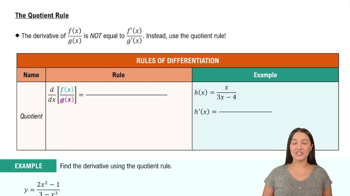Table of contents
- 0. Functions7h 52m
- Introduction to Functions16m
- Piecewise Functions10m
- Properties of Functions9m
- Common Functions1h 8m
- Transformations5m
- Combining Functions27m
- Exponent rules32m
- Exponential Functions28m
- Logarithmic Functions24m
- Properties of Logarithms34m
- Exponential & Logarithmic Equations35m
- Introduction to Trigonometric Functions38m
- Graphs of Trigonometric Functions44m
- Trigonometric Identities47m
- Inverse Trigonometric Functions48m
- 1. Limits and Continuity2h 2m
- 2. Intro to Derivatives1h 33m
- 3. Techniques of Differentiation3h 18m
- 4. Applications of Derivatives2h 38m
- 5. Graphical Applications of Derivatives6h 2m
- 6. Derivatives of Inverse, Exponential, & Logarithmic Functions2h 37m
- 7. Antiderivatives & Indefinite Integrals1h 26m
- 8. Definite Integrals4h 44m
- 9. Graphical Applications of Integrals2h 27m
- 10. Physics Applications of Integrals 2h 22m
3. Techniques of Differentiation
Product and Quotient Rules
Problem 3.14
Textbook Question
9–61. Evaluate and simplify y'.
y = (2x−3)x^3/2
 Verified step by step guidance
Verified step by step guidance1
Step 1: Identify the function y = (2x - 3)x^{3/2}. This is a product of two functions, so we will use the product rule to differentiate it.
Step 2: Recall the product rule for differentiation: if y = u(x)v(x), then y' = u'(x)v(x) + u(x)v'(x). Here, let u(x) = 2x - 3 and v(x) = x^{3/2}.
Step 3: Differentiate u(x) = 2x - 3. The derivative u'(x) is 2, since the derivative of 2x is 2 and the derivative of a constant is 0.
Step 4: Differentiate v(x) = x^{3/2}. Use the power rule for differentiation: if v(x) = x^n, then v'(x) = nx^{n-1}. Here, n = 3/2, so v'(x) = (3/2)x^{1/2}.
Step 5: Apply the product rule: y' = u'(x)v(x) + u(x)v'(x). Substitute u'(x), v(x), u(x), and v'(x) into this formula to find y'.
 Verified video answer for a similar problem:
Verified video answer for a similar problem:This video solution was recommended by our tutors as helpful for the problem above
Video duration:
4mPlay a video:
Was this helpful?
Key Concepts
Here are the essential concepts you must grasp in order to answer the question correctly.
Differentiation
Differentiation is a fundamental concept in calculus that involves finding the derivative of a function. The derivative represents the rate of change of the function with respect to its variable. In this case, we need to apply differentiation rules to the given function y = (2x−3)x^(3/2) to find y'.
Recommended video:

Finding Differentials
Product Rule
The Product Rule is a specific rule used in differentiation when dealing with the product of two functions. It states that if you have two functions u(x) and v(x), the derivative of their product is given by u'v + uv'. In the context of the given function, we will apply the Product Rule to differentiate the two components: (2x−3) and x^(3/2).
Recommended video:
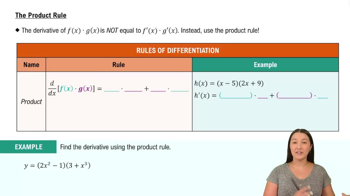
The Product Rule
Simplification
Simplification in calculus involves reducing an expression to its simplest form after differentiation. This may include combining like terms, factoring, or reducing fractions. After finding the derivative y', it is essential to simplify the expression to make it easier to interpret and use in further calculations.
Recommended video:
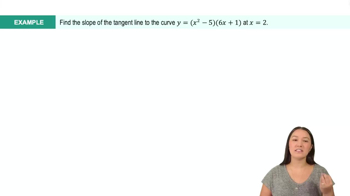
The Product Rule Example 2
Related Videos
Related Practice



